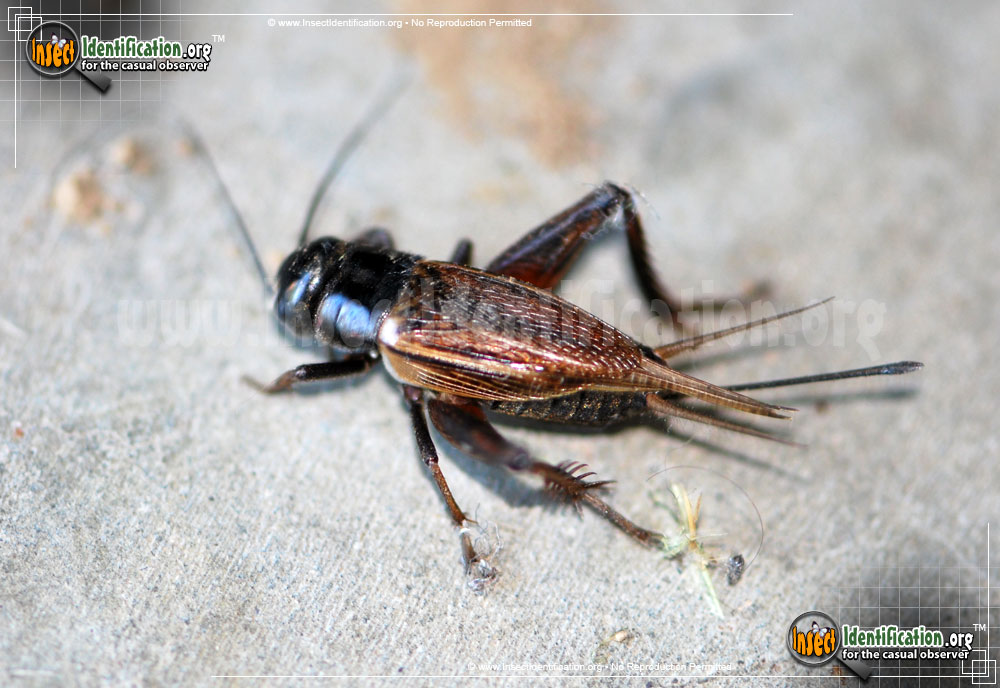See Taxonomy section
Crickets, family Gryllidae (also known as "true crickets"), are insects somewhat related to grasshoppers and more closely related to katydids or bush crickets (family Tettigoniidae). They have somewhat flattened bodies and long antennae.
Crickets are known for their chirp (which only male crickets can do; male wings have ridges or "teeth" that act like a "comb and file" instrument). The left forewing has a thick rib (a modified vein) which bears 50 to 300 "teeth". The chirp is generated by raising their left forewing to a 45 degree angle and rubbing it against the upper hind edge of the right forewing, which has a thick scraper (Berenbaum 1995). This sound producing action is called "stridulation" and the song is species-specific. There are two types of cricket songs: a calling song and a courting song. The calling song attracts females and repels other males, and is fairly loud. The courting song is used when a female cricket is near, and is a very quiet song. Female crickets have a long needlelike egg-laying organ (ovipositor).
Crickets chirp at different rates depending on their species and the temperature of their environment. Most species chirp at higher rates the higher the temperature is (approx. 60 chirps a minute at 13°C in one common species; each species has its own rate). The relationship between temperature and the rate of chirping is known as Dolbear's Law. In fact, according to this law, it is possible to calculate the temperature in Fahrenheit by adding 40 to the number of chirps produced in 15 seconds by the snowy tree cricket common in the United States.
To hear the mating call of other crickets, a cricket has ears located on its knees, just below the joint of the front legs.
There are about 900 species of crickets. They tend to be nocturnal and are often confused with grasshoppers, with which they are related, because they have a similar body structure including jumping hind legs.
In 1970, Dr. William H. Cade discovered that the parasitic tachinid fly Ormia ochracea is attracted to the song of the male cricket, and uses it to locate the male in order to deposit her larvae on him. It was the first example of a natural enemy that locates its host or prey using the mating signal. Since then, many species of crickets have been found to be carrying the same parasitic fly, or related species.
New genus
Crickets are omnivores and scavengers feeding on organic materials, as well as decaying plant material, fungi, and some seedling plants. Crickets mate in late summer and lay their eggs in the fall. The eggs hatch in the spring and they usually hatch in groups of 2,000.
Popular culture
Subfamilies of the family Gryllidae:
In addition to the above subfamilies in the family Gryllidae, several other orthopteran groups outside of this family also may be called "crickets":
Australian brown field cricket

Eneopterinae —
Gryllinae — common or field crickets; brown or black; despite the name, some of them enter houses (e.g. Acheta domesticus, the house cricket)
Nemobiinae — ground crickets
Oecanthinae — tree crickets; usually green with broad, transparent wings; frequent trees and shrubs.
Phalangopsinae
Podoscirtinae — anomalous crickets
Pteroplistinae
Trigonidiinae — sword-tail crickets
Mogoplistidae — scaly crickets
Myrmecophilidae — ant crickets
Mole crickets
Tettigoniidae - katydids or bush crickets
Cave crickets (also called camel crickets)
Sand crickets
Mormon crickets
Weta crickets
Jerusalem crickets
Parktown prawns Footnotes
Insect fighting
Nematomorpha
G. W. Pierce
No comments:
Post a Comment